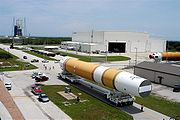
Common Booster Core
Encyclopedia

United States
The United States of America is a federal constitutional republic comprising fifty states and a federal district...
rocket stage, which is used on the Delta IV rocket as part of a modular rocket system. Delta IV rockets flying in the Medium and Medium+ configurations each use a single Common Booster Core as their first stage, whilst the Heavy configuration uses three; one as the first stage and two as boosters. The Common Booster Core is 40.8 metres (133.9 ft) long, has a diameter of 5.1 metres (16.7 ft) and is powered by a single RS-68 engine burning liquid hydrogen
Liquid hydrogen
Liquid hydrogen is the liquid state of the element hydrogen. Hydrogen is found naturally in the molecular H2 form.To exist as a liquid, H2 must be pressurized above and cooled below hydrogen's Critical point. However, for hydrogen to be in a full liquid state without boiling off, it needs to be...
and liquid oxygen
Liquid oxygen
Liquid oxygen — abbreviated LOx, LOX or Lox in the aerospace, submarine and gas industries — is one of the physical forms of elemental oxygen.-Physical properties:...
.
The first static test firing of a Common Booster Core was conducted on 17 March 2001, and the final test of the initial programme was conducted on 6 May. Testing was conducted using Test Stand B-2 of the John C. Stennis Space Center
John C. Stennis Space Center
The John C. Stennis Space Center , located in Hancock County, Mississippi, at the Mississippi-Louisiana border, is NASA's largest rocket engine test facility.- History :...
, a facility originally constructed for testing of the first stages
S-IC
The S-IC was the first stage of the Saturn V rocket. The S-IC first stage was built by The Boeing Company. Like the first stages of most rockets, most of its mass of over two thousand metric tonnes at launch was propellant, in this case RP-1 rocket fuel and liquid oxygen oxidizer...
of Saturn V
Saturn V
The Saturn V was an American human-rated expendable rocket used by NASA's Apollo and Skylab programs from 1967 until 1973. A multistage liquid-fueled launch vehicle, NASA launched 13 Saturn Vs from the Kennedy Space Center, Florida with no loss of crew or payload...
rockets during the 1960s. The first launch of a Common Booster Core was the maiden flight of the Delta IV, which was launched from Space Launch Complex 37B at the Cape Canaveral Air Force Station
Cape Canaveral Air Force Station
Cape Canaveral Air Force Station is an installation of the United States Air Force Space Command's 45th Space Wing, headquartered at nearby Patrick Air Force Base. Located on Cape Canaveral in the state of Florida, CCAFS is the primary launch head of America's Eastern Range with four launch pads...
on 20 November 2002.
The first flight of the Delta IV Heavy, featuring three Common Booster Cores, was conducted on 21 December 2004. On this flight all three CBCs malfunctioned, cutting off prematurely due to cavitation in their oxidiser lines, and resulting in the rocket reaching a lower orbit that that which had been planned. In response to the failure, additional pressure valves were installed on future launches.
As of September 2010, the Delta IV has made thirteen flights; ten in Medium and Medium+ configurations, and three in the Heavy configuration, resulting in a total of nineteen Common Booster Cores being launched.

